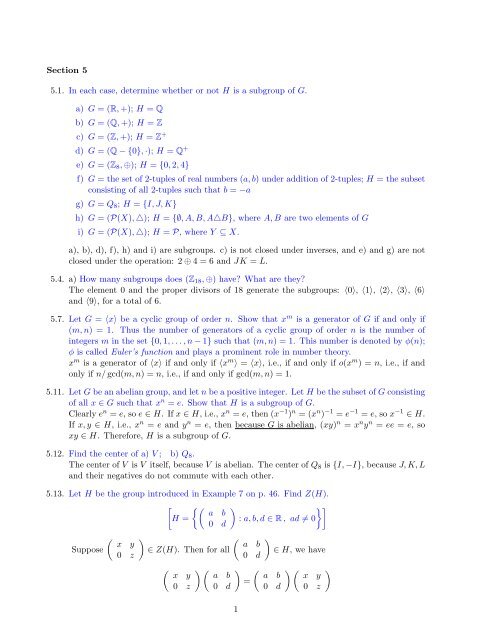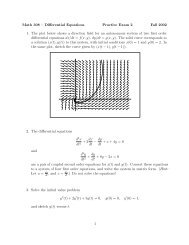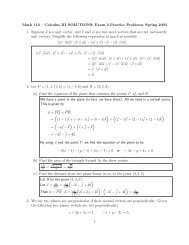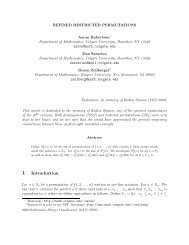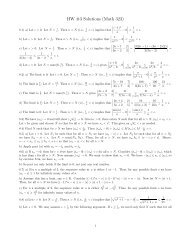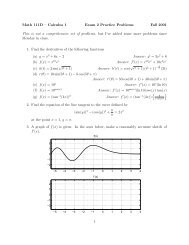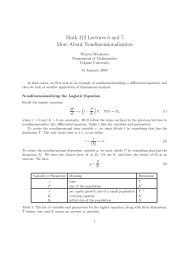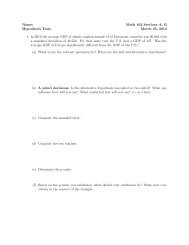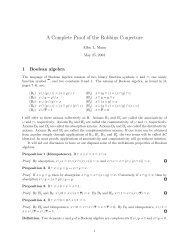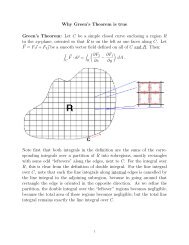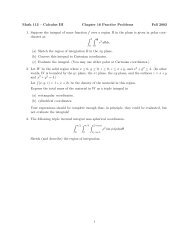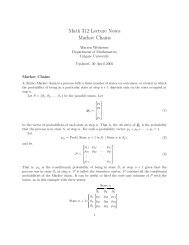Section 5 5.1. In each case, determine whether or not H is a ...
Section 5 5.1. In each case, determine whether or not H is a ...
Section 5 5.1. In each case, determine whether or not H is a ...
- No tags were found...
Create successful ePaper yourself
Turn your PDF publications into a flip-book with our unique Google optimized e-Paper software.
<strong>Section</strong> 5<br />
<strong>5.1.</strong> <strong>In</strong> <strong>each</strong> <strong>case</strong>, <strong>determine</strong> <strong>whether</strong> <strong>or</strong> <strong>not</strong> H <strong>is</strong> a subgroup of G.<br />
a) G = (R, +); H = Q<br />
b) G = (Q, +); H = Z<br />
c) G = (Z, +); H = Z +<br />
d) G = (Q − {0}, ·); H = Q +<br />
e) G = (Z 8 , ⊕); H = {0, 2, 4}<br />
f) G = the set of 2-tuples of real numbers (a, b) under addition of 2-tuples; H = the subset<br />
cons<strong>is</strong>ting of all 2-tuples such that b = −a<br />
g) G = Q 8 ; H = {I, J, K}<br />
h) G = (P(X), △); H = {∅, A, B, A△B}, where A, B are two elements of G<br />
i) G = (P(X), △); H = P, where Y ⊆ X.<br />
a), b), d), f), h) and i) are subgroups. c) <strong>is</strong> <strong>not</strong> closed under inverses, and e) and g) are <strong>not</strong><br />
closed under the operation: 2 ⊕ 4 = 6 and JK = L.<br />
5.4. a) How many subgroups does (Z 18 , ⊕) have What are they<br />
The element 0 and the proper div<strong>is</strong><strong>or</strong>s of 18 generate the subgroups: 〈0〉, 〈1〉, 〈2〉, 〈3〉, 〈6〉<br />
and 〈9〉, f<strong>or</strong> a total of 6.<br />
5.7. Let G = 〈x〉 be a cyclic group of <strong>or</strong>der n. Show that x m <strong>is</strong> a generat<strong>or</strong> of G if and only if<br />
(m, n) = 1. Thus the number of generat<strong>or</strong>s of a cyclic group of <strong>or</strong>der n <strong>is</strong> the number of<br />
integers m in the set {0, 1, . . . , n − 1} such that (m, n) = 1. Th<strong>is</strong> number <strong>is</strong> de<strong>not</strong>ed by φ(n);<br />
φ <strong>is</strong> called Euler’s function and plays a prominent role in number the<strong>or</strong>y.<br />
x m <strong>is</strong> a generat<strong>or</strong> of 〈x〉 if and only if 〈x m 〉 = 〈x〉, i.e., if and only if o(x m ) = n, i.e., if and<br />
only if n/ gcd(m, n) = n, i.e., if and only if gcd(m, n) = 1.<br />
5.11. Let G be an abelian group, and let n be a positive integer. Let H be the subset of G cons<strong>is</strong>ting<br />
of all x ∈ G such that x n = e. Show that H <strong>is</strong> a subgroup of G.<br />
Clearly e n = e, so e ∈ H. If x ∈ H, i.e., x n = e, then (x −1 ) n = (x n ) −1 = e −1 = e, so x −1 ∈ H.<br />
If x, y ∈ H, i.e., x n = e and y n = e, then because G <strong>is</strong> abelian, (xy) n = x n y n = ee = e, so<br />
xy ∈ H. Theref<strong>or</strong>e, H <strong>is</strong> a subgroup of G.<br />
5.12. Find the center of a) V ; b) Q 8 .<br />
The center of V <strong>is</strong> V itself, because V <strong>is</strong> abelian. The center of Q 8 <strong>is</strong> {I, −I}, because J, K, L<br />
and their negatives do <strong>not</strong> commute with <strong>each</strong> other.<br />
5.13. Let H be the group introduced in Example 7 on p. 46. Find Z(H).<br />
[ {( )<br />
}]<br />
a b<br />
H =<br />
: a, b, d ∈ R , ad ≠ 0<br />
0 d<br />
Suppose<br />
( x y<br />
0 z<br />
)<br />
∈ Z(H). Then f<strong>or</strong> all<br />
( x y<br />
0 z<br />
) ( a b<br />
0 d<br />
( a b<br />
0 d<br />
)<br />
=<br />
1<br />
)<br />
∈ H, we have<br />
( a b<br />
0 d<br />
) ( x y<br />
0 z<br />
)
i.e., ( xa xb + yd<br />
0 zd<br />
)<br />
=<br />
( ax ay + bz<br />
0 dz<br />
so xb + yd = ay + bz f<strong>or</strong> every value of a, b, d (with a, d nonzero). If we take a = b = d = 1,<br />
we see we must have x = z, and then ( taking ) a = 1, b = 0 and d = 2, we see that we must<br />
x 0<br />
have y = 0. It <strong>is</strong> easy to check that<br />
commutes with every element of H, no matter<br />
0 x<br />
what (nonzero real number) x <strong>is</strong>, so<br />
{( ) }<br />
x 0<br />
Z(H) =<br />
: x ≠ 0 .<br />
0 x<br />
5.17. Suppose H <strong>is</strong> a nonempty finite subset of a group G and H <strong>is</strong> closed under inverses. Must H<br />
be a subgroup of G Either prove that it must, <strong>or</strong> give a counterexample.<br />
A counterexample <strong>is</strong> {1, −1} ⊆ Z.<br />
5.18. a) Show that it <strong>is</strong> impossible f<strong>or</strong> a group G to be the union of two proper subgroups.<br />
Assume, by way of contradiction, that G = A ∪ B where A, B are proper subgroups. Pick<br />
x ∈ G − A and y ∈ G − B; then we must have x ∈ B and y ∈ A. Then we claim that<br />
xy <strong>is</strong> in neither A n<strong>or</strong> B, contradicting the assumption. If xy ∈ A, then x = (xy)y −1 ∈ A,<br />
contradicting our choice of A; and if xy ∈ B, then y = x −1 (xy) ∈ B, contradicting our choice<br />
of y. So xy ∈ G − (A ∪ B), the desired contradiction.<br />
b) Give an example of a group that <strong>is</strong> the union of three proper subgroups.<br />
V <strong>is</strong> the union of its three proper subgroups 〈a〉, 〈b〉 and 〈c〉.<br />
5.21. Let G = 〈x〉 be a cyclic group of <strong>or</strong>der n. Find a condition on the integers r and s that <strong>is</strong><br />
equivalent to 〈x r 〉 ⊆ 〈x s 〉.<br />
We have: 〈x r 〉 ⊆ 〈x s 〉 if and only if x r ∈ 〈x s 〉, which <strong>is</strong> true if and only if r = st + nu f<strong>or</strong> some<br />
integers t, u, which <strong>is</strong> true if and only if gcd(s, n)|r.<br />
5.22. Let G be a group. Prove that Z(G) <strong>is</strong> a subgroup of G<br />
The identity of G commutes with every element of G, so it <strong>is</strong> in Z(G). If x, y ∈ Z(G), i.e., f<strong>or</strong><br />
every g in G we have xg = gx and yg = gy, then f<strong>or</strong> every g in G we have (xy)g = x(yg) =<br />
x(gy) = (xg)y = (gx)y = g(xy), so xy ∈ Z(G). Finally, if x ∈ Z(G), i.e., xg = gx f<strong>or</strong> every<br />
g in G, then also xgx −1 = g and so gx −1 = x −1 g f<strong>or</strong> every g in G, so also x −1 ∈ Z(G).<br />
Theref<strong>or</strong>e, Z(G) <strong>is</strong> a subgroup of G.<br />
5.26. Let H be a subgroup of the group G and let N(H) = {a ∈ G | aHa −1 = H}. (See Exerc<strong>is</strong>e 5.25<br />
f<strong>or</strong> the definition of aHa −1 .) Prove that N(H) <strong>is</strong> a subgroup of G.<br />
We have eHe −1 = H, so e ∈ G. If aHa −1 = H, then aH = Ha and so H = a −1 Ha =<br />
a −1 H(a −1 ) −1 , so N(H) <strong>is</strong> closed under inverses. If aHa −1 = H and bHb −1 = H, then<br />
(ab)H(ab) −1 = abHb −1 a −1 = aHa −1 = H, so N(H) <strong>is</strong> closed under the operation. Theref<strong>or</strong>e,<br />
N(H) <strong>is</strong> a subgroup of G.<br />
)<br />
2


